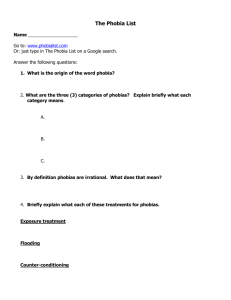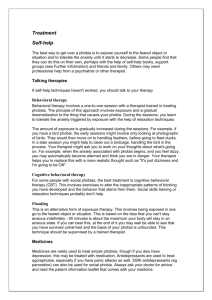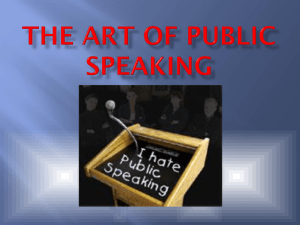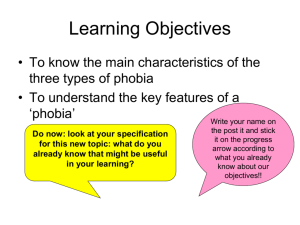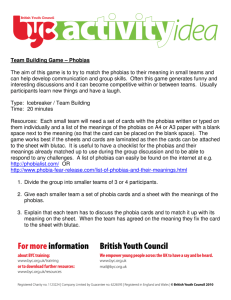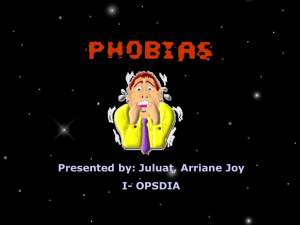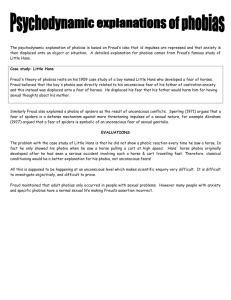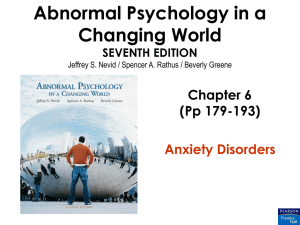Phobias - PE and Me
advertisement
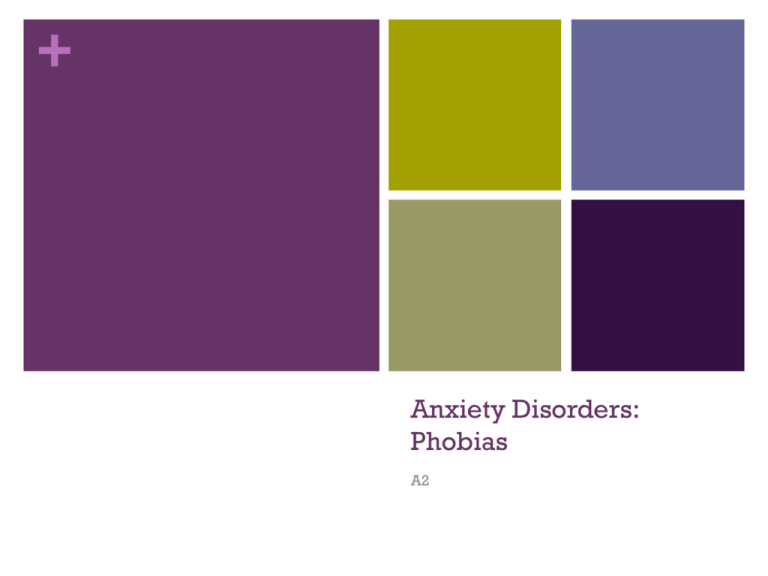
+ Anxiety Disorders: Phobias A2 + What is a phobia? With a partner write down your own definition. Once complete we will discuss your answers. + Official definition of a phobia: A phobia is defined as an irrational, intense fear of an object or situation that poses little or no actual danger. At first glance, a phobia may seem similar to a normal fear, but it's is the degree to which a person is affected that determines whether that fear has become a phobia. + + http://www.youtube.com/watch?v =4tEIh_fJ_9g + What is the difference between a fear and a phobia? + What is the difference between a fear and a phobia? Up to a fifth of people suffer from a fear or phobia (are you one of them?) The difference between fears and phobias is the degree of suffering. A fear of snakes is not often a problem in the UK & we can kind of get away with a fear of heights if we let someone else climb the ladder! A phobia is characterised by a marked and persistent fear. You will know that you are reacting completely over the top. Just thinking about the feared situation may cause you to feel the panic rising. You are desperate to avoid it and/or you worry endlessly in anticipation of being exposed to it. + What do you think the 10 most common phobias are? + What do you think the 10 most common phobias are? 1 ) Arachnophobia 2) Sociaphobia 3) Aviophobia 4) Agoraphobia 5) Claustrophobia 6) Acrophobia 7) Emetophobia 8) Carcinophobia 9) Brontophobia 10) Necrophobia + What do you think the 10 most common phobias are? 1 ) Arachnophobia 2) Sociaphobia (slide coming up – DSM 5) 3) Aviophobia 4) Agoraphobia (Aoraphobia is a form of anxiety disorder, the abnormal fear of expecting or experiencing a difficult or embarrassing situation from which the sufferer cannot find an escape. 5) Claustrophobia + What do you think the 10 most common phobias are? 6) Acrophobia 7) Emetophobia (an excessive or irrational fear of vomiting) 8) Carcinophobia (Fear of Cancer) 9) Brontophobia 10) Necrophobia (Fear of death or dead things) + DSM-IV diagnostic criteria for 300.23 Social Phobia 1) A marked and persistent fear of one or more social or performance situations in which the person is exposed to unfamiliar people or to possible scrutiny by others. The individual fears that he or she will act in a way (or show anxiety symptoms) that will be humiliating or embarrassing. Note: In children, there must be evidence of the capacity for age-appropriate social relationships with familiar people and the anxiety must occur in peer settings, not just in interactions with adults. 2) Exposure to the feared social situation almost invariably provokes anxiety, which may take the form of a situationally bound or situationally predisposed Panic Attack. Note: In children, the anxiety may be expressed by crying, tantrums, freezing, or shrinking from social situations with unfamiliar people. 3) The person recognizes that the fear is excessive or unreasonable. Note: In children, this feature may be absent. + Group tasks 1) Features and symptoms of phobias 2) Psychological Explanation of Phobias: Learning Approach 3) Psychodynamic Explanation of Phobias 4) Observational conditioning of fear-relevant Vs fearirrelevant stimuli in rhesus monkeys (Cook and Mineka, 1989) – key study + 1) Features and symptoms of phobias: Definition Common types + 2) Psychological Explanation of Phobias: Learning Approach Classical conditioning Operant conditioning Two process theory – Mowrer, 1947 SLT EVALUATION + 3) Psychodynamic Explanation of Phobias Displacement Repression EVALUAION + 4) Observational conditioning of fear-relevant Vs fear-irrelevant stimuli in rhesus monkeys (Cook and Mineka, 1989) – key study APRC GRAVE + What you need to produce An interesting interactive powerpoint With a quiz at the end Including a hand out (within this add any exam questions, mark schemes and potential exam questions) + Read this: http://www.anxietyuk.org.uk/about-anxiety/diagnostic-andstatistical-manual-of-mental-disorders-dsm/ + Key areas in detail: Systematic Desensitisation (classical conditioning) Little Albert Study +
